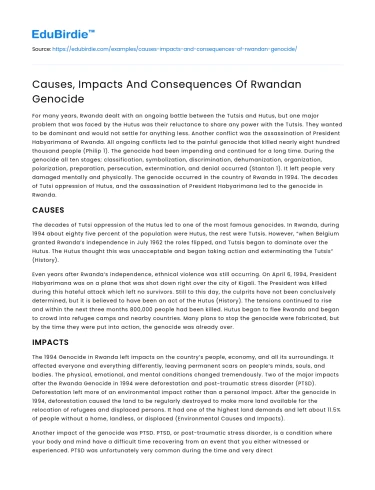For many years, Rwanda dealt with an ongoing battle between the Tutsis and Hutus, but one major problem that was faced by the Hutus was their reluctance to share any power with the Tutsis. They wanted to be dominant and would not settle for anything less. Another conflict was the assassination of President Habyarimana of Rwanda. All ongoing conflicts led to the painful genocide that killed nearly eight hundred thousand people (Philip 1). The genocide had been impending and continued for a long time. During the genocide all ten stages; classification, symbolization, discrimination, dehumanization, organization, polarization, preparation, persecution, extermination, and denial occurred (Stanton 1). It left people very damaged mentally and physically. The genocide occurred in the country of Rwanda in 1994. The decades of Tutsi oppression of Hutus, and the assassination of President Habyarimana led to the genocide in Rwanda.
CAUSES
The decades of Tutsi oppression of the Hutus led to one of the most famous genocides. In Rwanda, during 1994 about eighty five percent of the population were Hutus, the rest were Tutsis. However, “when Belgium granted Rwanda’s independence in July 1962 the roles flipped, and Tutsis began to dominate over the Hutus. The Hutus thought this was unacceptable and began taking action and exterminating the Tutsis” (History).
Save your time!
We can take care of your essay
- Proper editing and formatting
- Free revision, title page, and bibliography
- Flexible prices and money-back guarantee
Even years after Rwanda’s independence, ethnical violence was still occurring. On April 6, 1994, President Habyarimana was on a plane that was shot down right over the city of Kigali. The President was killed during this hateful attack which left no survivors. Still to this day, the culprits have not been conclusively determined, but it is believed to have been an act of the Hutus (History). The tensions continued to rise and within the next three months 800,000 people had been killed. Hutus began to flee Rwanda and began to crowd into refugee camps and nearby countries. Many plans to stop the genocide were fabricated, but by the time they were put into action, the genocide was already over.
IMPACTS
The 1994 Genocide in Rwanda left impacts on the country’s people, economy, and all its surroundings. It affected everyone and everything differently, leaving permanent scars on people’s minds, souls, and bodies. The physical, emotional, and mental conditions changed tremendously. Two of the major impacts after the Rwanda Genocide in 1994 were deforestation and post-traumatic stress disorder (PTSD). Deforestation left more of an environmental impact rather than a personal impact. After the genocide in 1994, deforestation caused the land to be regularly destroyed to make more land available for the relocation of refugees and displaced persons. It had one of the highest land demands and left about 11.5% of people without a home, landless, or displaced (Environmental Causes and Impacts).
Another impact of the genocide was PTSD. PTSD, or post-traumatic stress disorder, is a condition where your body and mind have a difficult time recovering from an event that you either witnessed or experienced. PTSD was unfortunately very common during the time and very directly impacted the people. More than a quarter of the people who survived the Rwandan genocide were diagnosed with post-traumatic stress disorder (Environmental Causes and Impacts). PTSD effects everyday lives by taking over the mind and body completely. It makes it very hard to process and function properly. It can cause suicidal thoughts or tendencies and is something that is uncontrollable. The reason that is was very common was because of the multiple deaths and murders that were witnessed. People had to watch even their own family members get beaten, abused, or even killed.
AFTERMATH
The 1994 genocide in Rwanda was different than any other. It was impending and happened quickly and abruptly, like a spark, rather than taking several years to strike. The violence killed seventy five percent of the population leaving Rwanda in one of the highest industrial scales. The communities were destroyed and many people were left permanently scarred because of the horror they had witnessed or lived through. Neighboring countries met and discussed ways that they could help, “Many troops were sent in and after a few months it was finally enough to put a halt to the killings” (Gourevitch). It has now been about 25 years since the genocide and the struggle from repercussions is evident. Violence continued for decades leaving people displaced, hurt, and heavily impacted. Many meetings have taken place to discuss how it is a priority and critical to ensure another genocide happens “Never again” (Brand). More time has been invested in preventing conflicts and efforts targeting violence. More focus has been put on programs addressing the issues, institutions, and anti-violence societies. Foreign policies have been made and stricter security was added. The people and governments have been working hard on the change that “needed to happen” and will help prevent another genocide from occurring. The genocide was a very harsh and heartbreaking time. Before, during, and after the genocide people were left scared and broken. It impacted the people and the world tremendously and unfortunately will leave a permanent imprint in all the people affected by it.
Works cited
- Brand, Mike. 'What Have We Learned.' The Nation, 17 Apr. 2019, www.thenation.com/article/rwanda-genocide-prevention/. Accessed 13 Oct. 2019.
- Gavin, Phillip. 'Rwanda 1994 800,000 Deaths.' The History Place, 1999, www.historyplace.com/worldhistory/genocide/rwanda.htm. Accessed 17 Sept. 2019.
- Gourevitch, Philip, narrator. Rwanda: The World Reacts.
- Munien, Suveshnee. 'Environmental Causes and Impacts of the Genocide in Rwanda.' Accord, 26 Oct. 2010, www.accord.org.za/ajcr-issues/%ef%bf%bcenvironmental-causes-and-impacts-of-the-genocide-in-rwanda/. Accessed 13 Oct. 2019.
- 'Rwandan Genocide.' HISTORY, A&E Television Networks, 14 Oct. 2009, www.history.com/topics/africa/rwandan-genocide. Accessed 10 Oct. 2019.
- Stanton, Gregory H. 'The Ten Stages of Genocide.' Classification Symbolization Discrimination Dehumanization Organization Polarization Preparation Persecution Extermination Denial, 2013. Originally published in Genocide Watch, 2013.






 Stuck on your essay?
Stuck on your essay?

